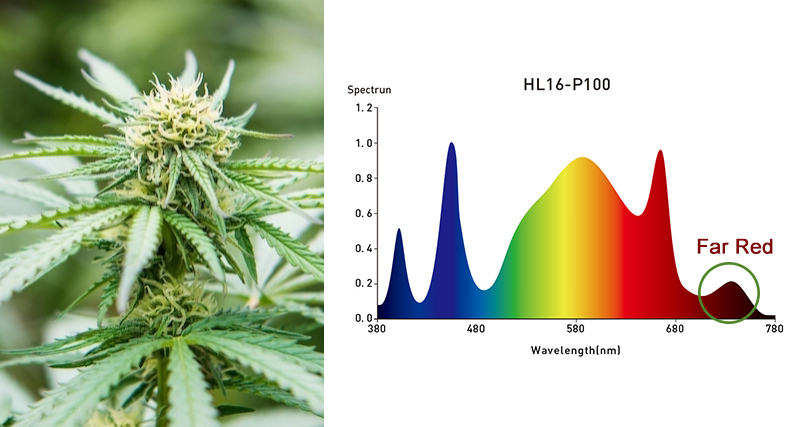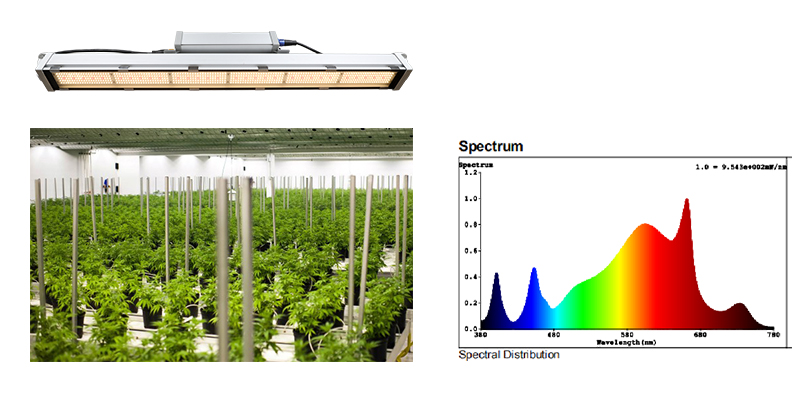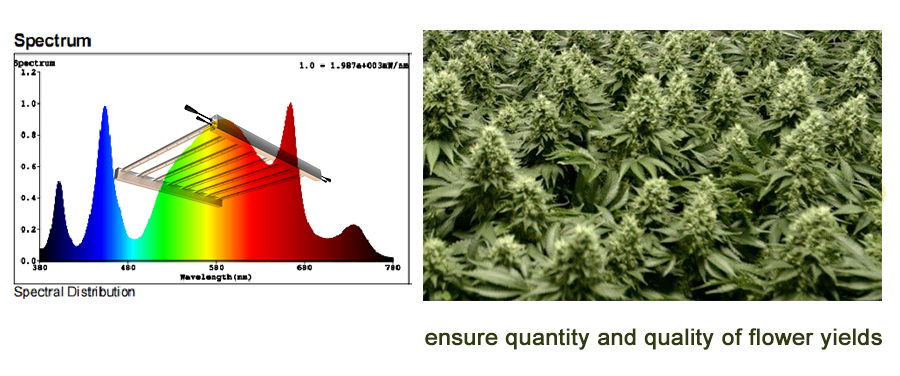The Effects of Far-Red Light on Crops Planting Beginners Must Know
Is far-red light necessary for the growth and development of crops? The answer is no, it is not a necessary condition. But if you add it to the spectrum of led grow lights, it might lead to better results for certain crops. maybe it's increased yields; maybe it's nutrient changes for the better; maybe it's an increase in certain plant extracts; maybe it's a change in plant photomorphogenesis; maybe it's a change in the biological cycle of certain plants. Because it involves different crop species and different reactions between different crops and far red light. Some crops respond favorably to far-red light, but this does not mean that all crops respond positively to far-red light. That's why we've singled out the effects of far-red light for analysis.

Light is an important participant in the growth and development of crops and participates in the whole life cycle of crops. And all this depends on the complex system of light perception and response that plants have evolved - photoreceptors. Plants have a range of photoreceptors. They can sense changes in the light quality and respond to different wavelengths. These photoreceptors regulate almost all aspects of plant growth and development.
In order to study the effect of far-red light on crops, we must first know the far-red light photoreceptors. Far-red and red light share the kindred photoreceptors-phytochromes. Phytochromes exist in two photoconvertible forms: Pr (R phytochrome) and Pfr (FR phytochrome). They lead together plant morphology and development.
The Pfr form (phytochrome) has an absorption peak at about 730nm and this differs from Pr form ( Phytochrome) which peak is at 660nm . Far red light drives phytochromes toward the Pr form whereas Red light drives phytochromes toward the Pfr form. The ratio of Red light and FR light is crucial because it determines the change direction of crops. In nature, plants exposed to direct sunlight , without any plant shade, receive R/FR in a ratio of about 1.1 to 1.2.
Before further elucidate the effects of far-red light, it is necessary to understand some phenomena of plants. When there is not enough light, plants may grow as high as they can to meet their light requirements. This is only one side of matter . On the lateral development of plants, they also may lengthen the length of their stems, internodes and petioles and extend the leaf area to stagger leaves that would otherwise shade each other.besides, they may also be flowering early. At this time, plants are like sentient person. They can judge the light conditions outsides to determine whether there is enough light to supply the later flowering and fruiting. If not, they may accelerate the development and flower early to ensure a harvest. Harvest is changeable, may be the flowering , may be the fruits,may be the seeds that are preferentially formed because of the need to reproduce. All of these changes show that the plant's growth potential has not been fully realized.they are just under the influence of external conditions. and the changes that plants make to get sunlight are known as shade avoidance syndrome (SAS).
The R:FR ratio of your light source is one indicator. In terms of the response of plants toward red and far red light,when the amount of red light is far more than far-red light , plants will have a sense of “satiety”. At this moment, they don't feel the need to make any changes, that is, they won’t urgently grow taller or extend their branches to get more lighting and they will grow at a normal pace.
But if the situation is reversed, and there is more far-red light than red light, the plants experience a "sense of hunger." Even though the light is strong enough, they still feel as if they are not getting enough. This causes them to grow taller and extend the length of stems, internodes and petioles and expand leaf area to capture more of the light they need. plants raise the ratio of R:FR to lower their hunger by this means. This is also a process of proportional regulation of red and far-red light.
Inevitably there are questions posed by people why not give up far-red light altogether. That's because Sunlight has a substantial amount of FR including FR into artificial light will make plants grow more more similar to those grown under sunlight, avoid some unknown changes, even make full use of the positive effects. As we mentioned at the beginning of this article, this is the significance of our study on the far-red light effects.

If your goal happens to be to make the crop taller and larger, then you can induce the change by adding the correct ratio of R:FR to the light source. The prerequisite is that you can't keep the far-red light higher than the red light for a long time and the health of the crops must be taken into account. Of course, not all crops show a shade avoidance syndrome,The sensitivity of plants to exhibiting the SAS ultimately depends on their evolutionary and/ or breeding history and whether they are shade avoiding or shade tolerant.
Far-red light has a great effect on the germination of some seeds. The essence is the effect of phytochromes on planting germination. photic seeds will not germinate if far red light is more than red light at the early stage of germination as far red light has caused them a shading effect. This shading effect will mislead the seeds into thinking they are not receiving the light stimulation of germination and then they will act normally in the state what they sense- seeds are still in the dormancy state and there is no sign of germination.
The utilization of far-red light during germination stage mainly focuses on the period after they have broken dormancy and sprouted new and tender shoots . when other growth conditions have gotten satisfaction, far-red light is used to propel seeds to grow rapidly into healthy seedlings via elongating the stem of tender shoots and widening leaves.
The effect of far-red light on crop flowering time is somewhat complicated. Because it involves the variety of crop and photoperiod of the crop. The diversity of crops and the complicacy of photoperiodic properties (short-day plants, long-day plants, Day-neutral plants) make it hard to generalize. For many plants , far-red light can affect their perception of the photoperiod and cause them to bloom earlier. While for other plants, far-red light may has no effect on crop flowering time at all, or even may delay flowering time of some crops species.
Far-red light not only can affect the flowering time of some crops, but also can affect the quantity and quality of some crop yield. cannabis is a plant that produces its early product in the form of dried flowers. The inclusion of a proper amount of far-red light in led grow lights used for growing cannabis indoors can ensure the quantity and quality of cannabis flowering yields.

Moreover,Far-red light also increases the tolerance of some crops to low temperature and salt. it means that far-red light makes plants more resistant to harsh weather and soil conditions. Despite so many benefits we have listed above, far-red light is not without its inhibitory effects, such as inhibition of seed germination, inhibition of root growth in some crops and nodules reduction in some legume roots which further affects legumes intake of the nutrient.
Therefore ,far-red light can be used, but not abused. Before being put into use, it is important to determine the optimal dose of far-red light for the planted crop. Although there is still a lot of uncertainty about the effects of far-red light on various crops, we can still benefit the planting industry by taking advantage of some of the characteristics we know and the amount of far-red light that best achieves these characteristics. Determining the optimal amount of benefit for far-red light is still a long-term and arduous task requiring our continuous exploration.

